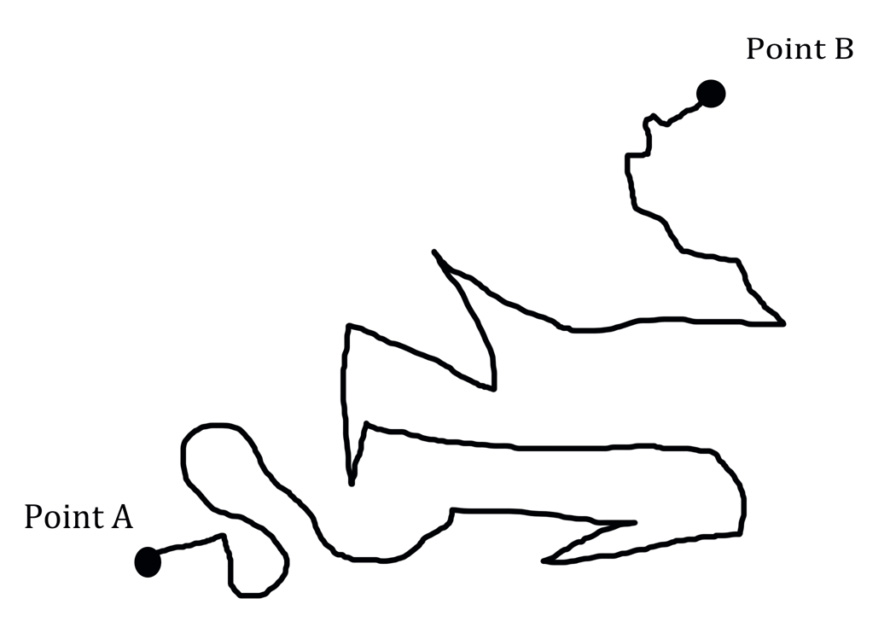
Our Evolving Organization
I’m pretty excited! On February 27th, FHI turned 12 years old. Of course, we haven’t always had the same name, and we have evolved a lot over that time. I will spare you a long list of accomplishments, but I am proud of the work we have done and the great training we have provided. Perhaps more importantly, I am excited about how we continue to evolve and I would like to share a little bit about that with you.
Remember the squiggly path from A to B? The one our lives tend to follow, instead of the straight line. Well, organizations do that too.

Three years ago, FHI was asked by the City and County of Denver’s CSBG program to create a “Symposium on Scarcity.” The concept behind the symposium was that organizations that are experiencing “organizational scarcity” actually behave a lot like individuals who are experiencing “personal scarcity.” We researched several organizations who had navigated some pretty intense economic shocks successfully and were able to discern that there are some common strategies that these successful organizations used.
As a result of our experience hosting that symposium, I became interested in how our organizations can be more effective and efficient with their resources. But of course, my interest, as always, goes back to how training and learning is used.
How effective are all these trainings, anyway?
We started looking at how training is delivered within human services and economic development programs and found that a lot of our trainings turn out be pretty big information dumps, where we send people to half-day, full-day, two-day trainings—we give people a ton of information and when they leave, there’s no real implementation process to support them when they return to work.
When I was out in the field, I would ask people what they remember about these trainings, and typically they would admit that they used very little from most trainings they attended, and that they actually remembered very little of the content. Wow! What? How many trainings and conferences do we send people to with no real learning objectives or strategies for implementation? How much money and time do we spend on these trainings?
So let’s recap: we give everyone a ton of information in a very short period of time and then cross our fingers and hope they use it!
(I won’t mention that in many cases, there is not a plan prior to the training as to how it will be used, there is not necessarily any specific look at how trainings line up with the organizations’ missions, there is not a plan as to how the program will be implemented when participants return and there’s no data collected after the trainings to see if people are using it or if it was effective. I won’t mention that.)
Of course, I believe the information FHI provides is so super important that there’s no way people wouldn’t implement it! But that was not the case. We started testing our own programs and actually found the same thing. People who went through FHI’s two-day intensive trainings were not retaining information or implementing it, and there was no plan as to how it would be used after the class. So, while people enjoyed that class—how effective was it really?
The evolution of Integrated Learning
I can’t live with that: it’s a waste of everyone’s time and money. Therefore, two years ago, FHI launched what we now call our “Integrated Learning Programs.” The point behind Integrated Learning is to provide ongoing, blended (live and online) trainings and strategies to help participants more effectively retain and implement our training within their organizations.
We have shifted our view of training from delivering classes to delivering a learning process that supports the learner over a full year. As a result, FHI has developed over 35 online courses that support our live trainings and are designed to assist with implementation. AND we can track how people are interacting with the content. Yeah, data!
The evolution of training design
That is pretty cool, but what came next was even more cool. With our new skill sets, organizations started asking us to design trainings for them. But the coolest of the cool was that we were asked to begin designing training systems that would pull together training for multiple organizations. We now have developed these kinds of training systems for multiple programs and organizations within the state of Colorado. And in February, on our 12th birthday, we expanded into Nevada. Yep—I spent the organization’s 12th birthday in Vegas! (I can’t tell you what happened there. It’s a law.)
As a team, FHI has huddled up and determined that our old mission and vision statements no longer really fit who we have become and therefore we have been working diligently to revise our foci. We are also developing a course catalog so that everyone knows the full scope of the training and design services we offer. And finally, we will continue to advocate strongly for the continued improvement of training and learning in the fields of human services and economic development.
A present for you
In recognition of our 12th birthday, and our interest in integrating systems, here is an online course as our gift to you: A Holistic Approach to Economic Security and Well-Being. Use the coupon code: HOLISTIC to receive the course for free.

